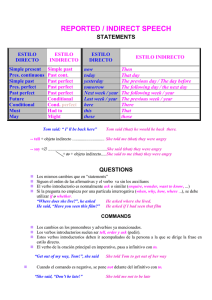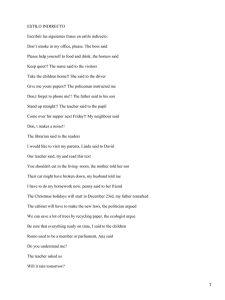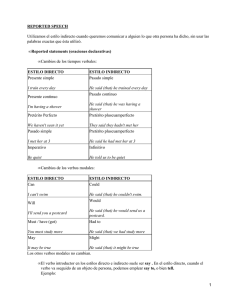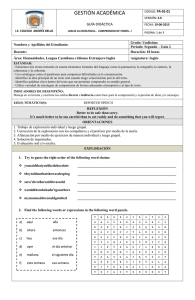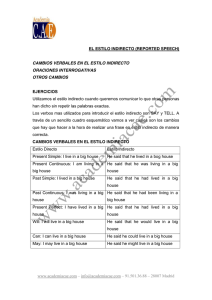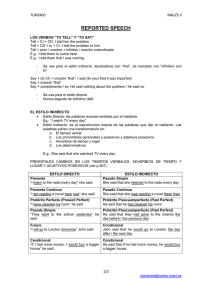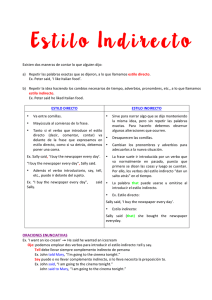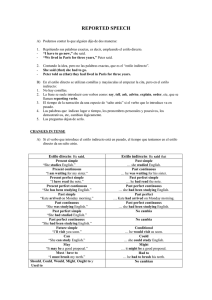ESTILO INDIRECTO (Indirect or reported speech)
Anuncio
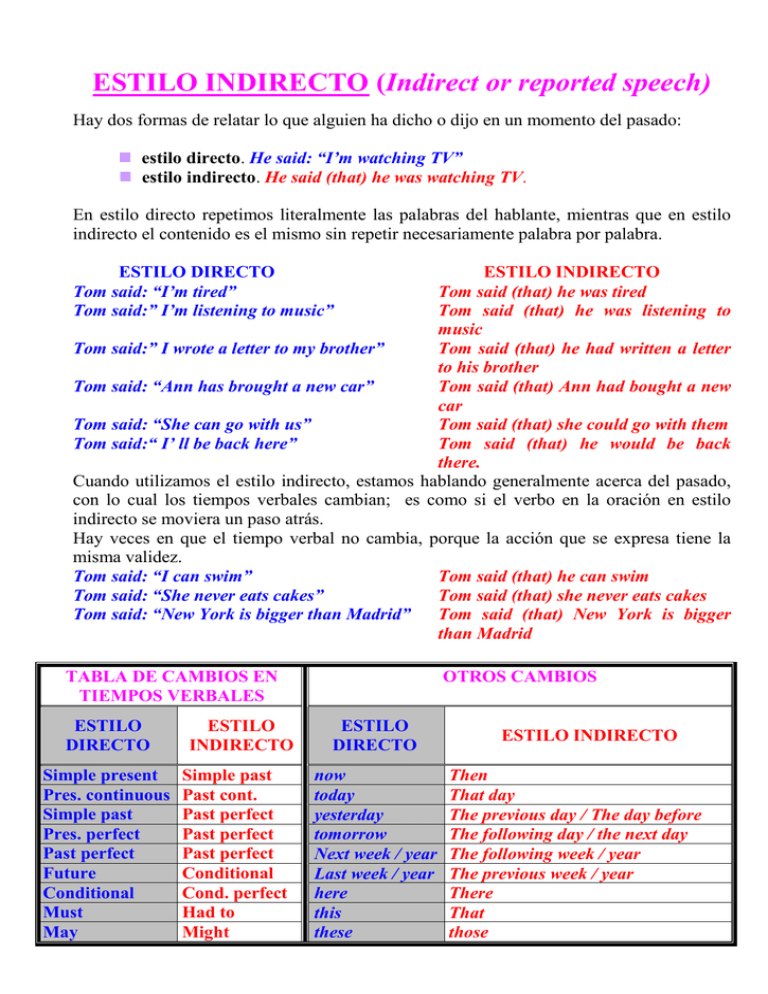
ESTILO INDIRECTO (Indirect or reported speech) Hay dos formas de relatar lo que alguien ha dicho o dijo en un momento del pasado: estilo directo. He said: “I’m watching TV” estilo indirecto. He said (that) he was watching TV. En estilo directo repetimos literalmente las palabras del hablante, mientras que en estilo indirecto el contenido es el mismo sin repetir necesariamente palabra por palabra. ESTILO DIRECTO Tom said: “I’m tired” Tom said:” I’m listening to music” ESTILO INDIRECTO Tom said (that) he was tired Tom said (that) he was listening to music Tom said:” I wrote a letter to my brother” Tom said (that) he had written a letter to his brother Tom said: “Ann has brought a new car” Tom said (that) Ann had bought a new car Tom said: “She can go with us” Tom said (that) she could go with them Tom said:“ I’ ll be back here” Tom said (that) he would be back there. Cuando utilizamos el estilo indirecto, estamos hablando generalmente acerca del pasado, con lo cual los tiempos verbales cambian; es como si el verbo en la oración en estilo indirecto se moviera un paso atrás. Hay veces en que el tiempo verbal no cambia, porque la acción que se expresa tiene la misma validez. Tom said: “I can swim” Tom said (that) he can swim Tom said: “She never eats cakes” Tom said (that) she never eats cakes Tom said: “New York is bigger than Madrid” Tom said (that) New York is bigger than Madrid TABLA DE CAMBIOS EN TIEMPOS VERBALES ESTILO DIRECTO Simple present Pres. continuous Simple past Pres. perfect Past perfect Future Conditional Must May ESTILO INDIRECTO Simple past Past cont. Past perfect Past perfect Past perfect Conditional Cond. perfect Had to Might OTROS CAMBIOS ESTILO DIRECTO now today yesterday tomorrow Next week / year Last week / year here this these ESTILO INDIRECTO Then That day The previous day / The day before The following day / the next day The following week / year The previous week / year There That those Los pronombres personales y los adjetivos posesivos también cambian, generalmente de primera o segunda persona el estilo directo, a tercera persona en estilo indirecto (ver ejemplos) PRACTICE: Put the following sentences into reported speech: 1.- “I arrived here last week”, he said. 2.- “I always go camping in summer, she said. 3.- “It isn’t so foggy today as it was yesterday”, I remarked. 4.- “I’ve just bought a new car, but I can’t drive it”, my mother told me. 5.- “My brother wants to be a taxi driver”, said Mary. 6.- “I’ve got no idea what the time is, but I’ll dial 123 and find out”, said Tom. 7.- “All the students must study hard”, the teacher said. 8.- “They stole this dress from here”, the police said. 9.- “I’d like a salad to start with”, said my girlfriend. 10.- “The murderer had killed her”, said the officer. VERBOS INTRODUCTORIOS BÁSICOS Suelen ser say, tell, explain, remark, shout, complain, siempre en pasado. Say y tell tienen diferente estructura gramatical: -- tell + objeto indirecto .............................. She told me (that) they were angry -- say + .......................................................She said (that) they were angry + to + objeto indirecto .......... She said to me (that) they were angry PRACTICE: Use the correct form of SAY or TELL in these sentences: 1.- She……………. me she didn’t agree. 2.-He……………., “Have we met before?” 3.- I…………. them I wasn’t happy with her work. 4.- She………… to me and smiled. 5.- Could you………… me the time? LAS PREGUNTAS EN ESTILO INDIRECTO Sufren los siguientes cambios: Los mismos en los pronombres, tiempos verbales y adverbios ya mencionados La construcción interrogativa se transforma siguiendo el orden de las afirmativas y el verbo va sin los auxiliares que le corresponderían en estilo directo. “Where does she live?”, he asked He asked where she lived. El verbo introductorio es normalmente ask o similar (enquire, wonder, want to know, ...) Si la pregunta no empieza por una partícula interrogativa (when, why, how, where ...), se debe utilizar el conectivo if o whether. He said, “Have you seen this film?” He asked if I had seen that firm PRACTICE: Put the following sentences into reported speech: 1.- “What is your new house like?”, I asked them. 2.- “Can I buy some cigarettes here?”, I asked the attendant. 3.-“ Did you hear a terribly crash this morning?”, said Mary. 4.-“ Are you going to London tomorrow?”, the boss said. 5.- “Are you sorry for what you did?”, the mother said to the child. 6.- “Where have you been?”, his parents asked him. 7.- “Do you have the driving licence?”, the policeman asked the driver. 8.- “Will you be a better boy?”, the mother said to the child. 9.- “Have you studied yet?, the teacher said. 10.-“Why are you driving on the right?”, the policeman asked the driver. LAS ÓRDENES Y PETICIONES EN ESTILO INDIRECTO “Get out of my way, Tom!”, she said She told Tom to get out of her way Las oraciones imperativas sufren los siguientes cambios: Los mismos en los pronombres y adverbios ya mencionados. Los verbos introductorios suelen ser tell, order y ask (pedir). Estos verbos introductorios deben ir acompañados de la persona a la que se dirige la frase en estilo directo. El verbo de la oración principal en estilo directo, pasa a infinitivo con to. Cuando el comando es negativo, se pone not delante del infinitivo con to. “She said, “Don’t be late!” She told me not to be late PRACTICE: Put the following sentences into reported speech: 1.- “Don’t put sticky things in your pockets”, said his mother to the child. 2.- “Follow that car!”, the detective said to the taxi driver. 3.- “Could you phone Ana?”, I told Tom. 4.- “Please, close the door”, the teacher said. 5.- “Joe, I’d like you to work late”, my boss said. 6.- “Please, don’t smoke in my car”, I told you twice. 7.- My girlfriend remember me, “Write to me every week”. 8.- “Don’t play cards for money”, the mother said to the child. VERBOS INTRODUCTORIOS AFIRMACIONES PREGUNTAS ÓRDENES SÚPLICAS SUGERENCIAS Admit, announce, answer, apologise, boast, claim, complain, declare, explain, inform, insist, mention, offer, remind, reply, state Enquire, request, want to know, wonder Demand, order, shout, warn Beg Advise, invite, recommend, suggest ESTRUCTURAS ESPECIALES Hay verbos introductorios con características diferentes: -- Apologize + for + -ing “I’m sorry. I’m late” He apologized for being late -- Invite + (somebody) + to + inf. “Do you like a coffee?” He invited me to drink a coffee -- Offer + to + inf “I’ll open it for you” He offered to open it for me -- Suggest (that) “Why don’t you do it?” + (should) + inf. He suggested (that) we (should) do it + gerund He suggested doing it. PRACTICE: Put the sentences into reported speech using the verb in brackets: 1.- “You should work harder”, said the teacher. (suggest) 2.- “I am very sorry. I lost your watch”, said Joana. (apologize) 3.- “I am innocent”, said Paul. (declare) 4.- “Would you like to come home?”, said Harry. (invite) 5.- “Let’s go”, said Peter. (suggest) 6.- “Do you want to meet at five?”, said Max (invite) 7.- “I’ll go and meet you at the station”, said Willy. (offer) 8.- “We’re prepared to do it”, said the student. (declare) 9.- “Why don’t you look for him?”, the boss said. (suggest) 10.- “We will buy the drinks”, my parents said. (offer)
